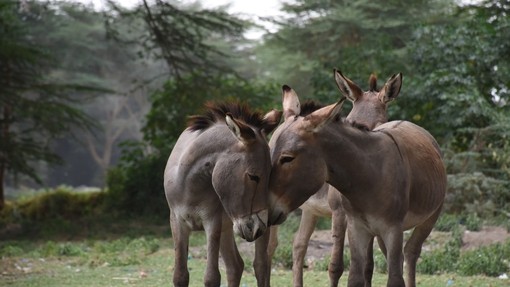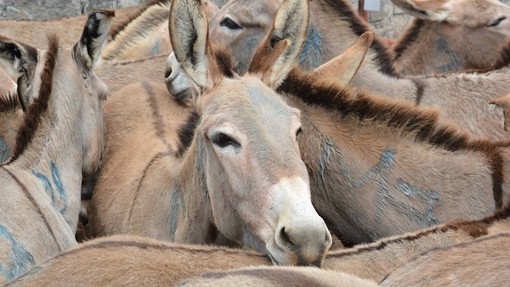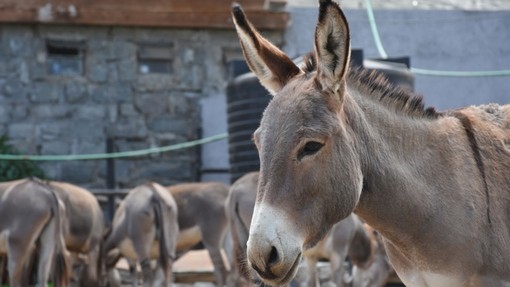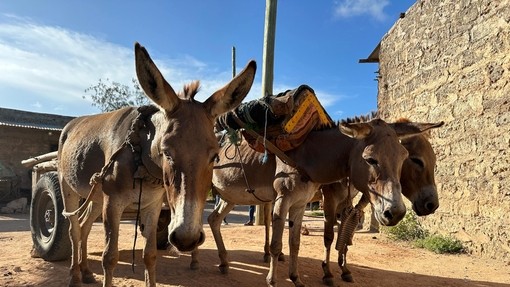End the donkey skin trade
At least 5.9 million donkeys are slaughtered for their skins every year.
The collagen from their skin produces ejiao, a traditional Chinese medicine. China’s domestic donkey population has collapsed, so, the ejiao industry has shifted to a global trade network to source its donkey skin to continue meeting demand. With such intense demand, skin traders look for a supply at any cost.
From source to slaughter, the donkeys who get caught up in this trade suffer at every stage. Donkeys die in often unregulated, inhumane, and unsanitary conditions, and large numbers perish on their way to slaughterhouses. Communities who depend on their donkeys to help provide them with a livelihood wake up to find their donkeys stolen, slaughtered, and skinned during the night. Families are losing donkeys that mean so much to them. Lives and opportunities are destroyed.
The transportation of untreated skins and improper disposal of donkey carcasses risk triggering the spread of infectious diseases and damaging local ecosystems. The Donkey Sanctuary has evidence that criminals are exploiting the skin trade and are smuggling and selling illegal products alongside donkey skins.
Innocent Lives: Stop the Slaughter
Help Stop the Slaughter
Understanding the donkey skin trade
What is the donkey skin trade?
The donkey skin trade is a cruel and largely unregulated international trade in donkey skins. The donkeys are often viciously slaughtered and their skins shipped to China.
What are the donkey skins used for?
The collagen from the donkey skins is used to create a product known as ejiao (pronounced uh-jee-ow), which is then used in food, drink or beauty products.
Is the donkey skin trade legal?
The trade is illegal in some countries and legal in others. It brings cruelty and suffering to donkeys wherever it operates.
Where the trade operates legally, its size and complexity mean it is almost entirely unregulated, with no means of monitoring donkeys’ welfare or tracking the source of individual skins.
Where the slaughter of donkeys and the export of their skins is illegal, donkeys are stolen and traded indiscriminately in defiance of national and local laws. There is also a wealth of evidence of links to organised criminal activity.
Do the donkeys suffer from the skin trade?
Yes. Unfortunately, the treatment of donkeys brings intense suffering at every stage of the skin trade. From their sourcing to their eventual slaughter, the conditions are unethical, unacceptable, and often illegal.
How many donkeys are slaughtered for the skin trade each year?
The largely unregulated and often illegal nature of the donkey skin trade makes it impossible to obtain the precise number of donkey skins required to keep up with demand levels for ejiao.
In 2016, a study conducted by The University of Reading calculated that the ejiao industry required between 2.3 and 4.8 million donkey skins to keep up with demand.
In 2023, our teams reviewed the University of Reading’s calculation, using updated figures reported by the ejiao industry in 2022. They found that the ejiao industry now requires a minimum of 5.9 million donkey skins to keep up with the latest demand.
The new figures are published in a high-level briefing document which sets out, for the first time in one place, comprehensive recommendations for the industries and governments which have the power to help bring an end to this cruel and unsustainable trade.
What impacts does the skin trade have on donkey owners?
The donkey skin trade has devastating and wide-ranging economic and educational impacts that disproportionately impact women and children.
Without their donkeys to help them, women and children spend more hours completing tasks, hindering economic mobility and reducing educational opportunities.
The communities whose donkeys are targeted by skin traders lose their valued animals, and their livelihoods are put at risk.
Latest News
Find out more
Learn about the multiple and catastrophic repercussions the skin trade has on donkeys and the communities that depend on them.

Learn about the traditional Chinese medicine that is driving the demand for donkey skins, and the possible alternatives for a humane future.

Learn about our approach to challenging the donkey skin trade and bringing a permanent end to the skin trade.

Find our reports on the donkey skin trade. We regularly publish reports based on our findings from investigative work.

Learn about cellular agriculture, a way of sustainably and humanely creating donkey collagen without the need for live animals.

Find out about the criminal elements currently using the donkey skin trade as a smokescreen for other illicit activities.

References
References
- At least 5.9 million donkey skins are needed yearly: Figures based on calculations from: Bennett & Pfuderer (2019). Discussion paper presented at: Agricultural Economics Society, 93rd Annual Conference. (15-17 April 2019). Warwick University, Coventry, UK.
- Using ejiao output estimates from: Hui, L (2017) China Focus: Donkey shortage turns TCM remedy into a luxury product, Xinhua, Available from: China Focus: Donkey shortage turns TCM remedy into a luxury product [Accessed 9 October 2023] and Li et al. (2022), Foresight 2022: Panorama of China’s donkey-hide gelatin industry. Prospective Industry Research Institute. Available from: Foresight 2022: Panorama of China’s donkey-hide gelatin industry [Accessed 9 October 2023].
- China’s domestic donkey population has collapsed: FAO (2021) FAOSTAT database. Food Agricultural Organisation UN Rome Italy. 2021:1. Available from: FOASTAT database. Cited in: The Donkey Sanctuary (2023) Donkeys in global trade: Wildlife crime, welfare, biosecurity, and the impact on women.
- Between 2.3 and 4.8 million donkey skins needed for ejiao industry in 2016: Bennett & Pfuderer (2019). Discussion paper presented at: Agricultural Economics Society, 93rd Annual Conference. (15-17 April 2019). Warwick University, Coventry, UK.






